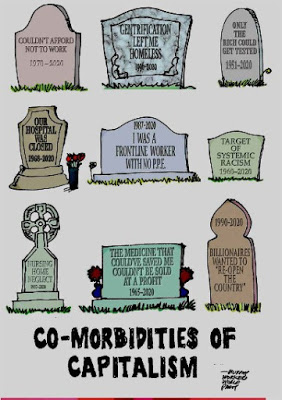COVID-19 and basic facts of Marxist economics
 |
| Deirdre Griswold 25/04/2020 |
The stock market crashed in March but partly recovered after the Federal Reserve Bank lowered the interest rate for borrowing. Then it crashed again. Companies are going bankrupt. The price of oil has dropped to its lowest level in decades.
All are signs of drastically decreased economic activity right now.
But what does that really mean?
It isn’t just that people aren’t buying as much stuff when they’re forced to stay home in this pandemic. Much more importantly, it means that far fewer workers are producing new value.
And that’s the key to what is happening to the capitalist economy now. When workers aren’t working, no new value is being created. The way the capitalist markets work, however, is that they anticipate more and more growth as workers go to work every day and create new value while being exploited by the bosses. When that’s not happening, there’s a big crisis.
Marxist economics is crucial to understanding what is behind the economic catastrophe accompanying the COVID-19 crisis. So here’s a very brief summary of some of the basics of Marxism.
Everything that is exchanged (usually for money), which we can’t just get for free, like plucking a dandelion, has to have two kinds of value. One is use value. The other is exchange value.
Use value vs. exchange value
The water we drink is probably one of the most valuable things we consume every day. Without it we would die. So the use value of water is enormous.
But it is also very cheap, meaning it has a very low exchange value. As vital as water is for life, it will never cost as much as champagne, for example — which is nice, but we can survive without it!
So why is water cheap?
In simplified terms, its price is low in relation to other things we buy (called commodities) because little labor is involved in making it available. That’s why it has a low exchange value.
Way back when the reservoirs in this country were first built, along with the aqueducts leading from them, quite a bit of labor went into providing water. But now oceans of water are flowing to cities and towns in many sections of the country with little human labor expended in the process. So water, in most areas, is a minor expense.
What’s not so cheap, of course, are the bottles of specialty waters from Fiji or some other distant source that are sold in stores all over. This water costs money, not because it might be better, but because of the labor it takes to locate sources, transport the water, bottle and market it.
You can probably think of lots of other commodities that have a high use value but a low exchange value. Flour, for example, the main ingredient in bread–called the staff of life. Pencils. Writing paper.
Other commodities may have limited use value, like binoculars you keep in your closet and barely use, but a much higher exchange value. They’re very costly compared to water.
So what is exchange value and how is it measured?
Human labor is the key
Exchange value is how much a commodity costs in relation to other commodities. And that is the key to measuring it: The exchange value of a commodity comes from how much human labor is incorporated into it. Let’s say it again: It is human labor — workers working — that creates all exchange value.
This is basic to Marxism, but is either ignored or downplayed by most bourgeois economists.
The more labor it takes to produce something, the more exchange value it will have. Exchange value isn’t the only factor determining price, of course. Prices can fluctuate according to supply and demand. But they fluctuate around a basic ingredient: how much labor it took to produce the commodity. No matter how much the market may be glutted with cars, for example, even an old, battered car will never sell for the same price as a loaf of bread.
Unemployment and the economic crisis
So, to come back to the current and growing economic crisis, Fortune magazine wrote on April 16: “Another 5.2 million Americans filed initial unemployment claims in the week ending April 11. That brings the total unemployment claims over the past four weeks to 22 million.”
These millions of workers have either lost their jobs or are housebound because of the virus — and therefore are not creating new value.
It’s the obvious explanation for the growing crisis of the economy — but not one you’re likely to read about in the newspapers or hear about on radio and television. The corporate media will report on unemployment as the result of the economic crisis, not the cause. But that is putting the cart before the horse.
To repeat, human labor — workers working — is the creator of all exchange value.
And right now, tens of millions of workers are quarantined or staying home under shelter-in-place orders. They are “essential workers” needed for the creation of new values, but are unable to do their jobs.
As a result, the capitalist economy is going into crisis mode.
Cartoons by Murphy, WWP


